Journey from Nairobi to Lodwar (NFD) – September 1958 |
|
|
|
|
 |
18. Night-stop on the equator between Nakuru and Eldoret. |
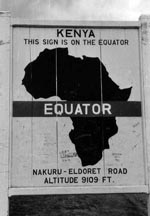 |
19. Sign on the equator. |
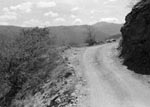 |
20. Road on the scarp slope from Kitale to the floor of the Rift Valley to the west of Lake Rudolf. |
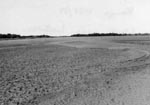 |
23. Crossing the dry bed of the River Turkwell near Lodwar. |
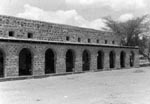 |
22. Base camp at Lodwar: The future hospital building used by us for accomodation. |
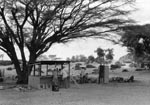 |
21. Base camp at Lodwar: The cookhouse being built of wood and corrugated iron sheeting. |
 |
55. Map of areas mentioned |
|
|
Astro fix point at Ferguson’s Gulf on the west bank of Lake Rudolf (now Lake Turkana) – September 1958 |
|
|
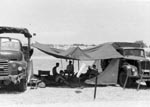 |
28. Typical ‘camp’ for an astro fix point, just a tent fly-sheet spread between two vehicles.
Some of us slept on top of the Bedford RL 3-tonner with the stars for our canopy. |
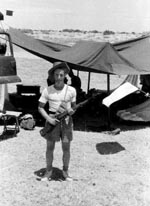 |
29. Bill in bush hat and with short-barelled bush rifle, used for protection and obtaining fresh meat. |
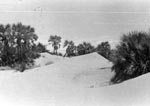 |
30. Sand dunes and dom palms close to Ferguson’s Gulf on Lake Rudolf. |
|
|
Area between Lokitaung and Namuruputh,
north-west of Lake Rudolf |
|
|
|
 |
27. Road through the Lodapalinga Hills near Lokitaung on the north-west side of Lake Rudolf. |
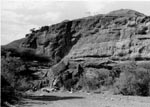 |
25. Road through the Lodapalinga Hills with baboons lining the top of the cliff face and throwing stones at us. |
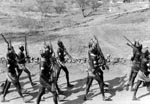 |
31. Road through the Lodapalinga Hills with baboons lining the top of the cliff face and throwing stones at us. |
|
|
Trip from Lodwar in Kenya to Loelli in the Sudan October 1958 |
|
|
|
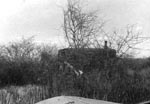 |
14. ‘Bush bashing’ through thick thorn bushes. |
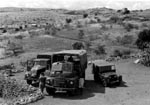 |
24. Our vehicles at Loelli Police Post. |
 |
26. A Kenya Police plane lands at Loelli airstrip with a spare part needed for the Morris one-tonner. |
|
|
Return journey from Loelli in the Sudan to Lodwar in Kenya |
|
|
|
|
 |
12. Into the wadi. Often, travelling was much quicker and pleasanter in the wadi bed, especially where the plains were strewn with lar |
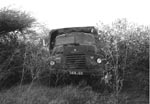 |
13. Out of the wadi |
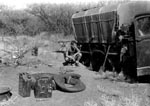 |
17. Puncture problems. We suffered three punctures in less than two hours. During the repair of the third one, the vibrations of the engine, started up to inflate the inner tube, made the Morris come off the jack.
We had to dig a big hole, then gradually jack up the lorry and pack wood under the axle to get the wheel back on. This was followed by a well-earned brew-up. |
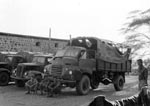 |
15. The state of the canvas covering on our return to Lodwar after bush-bashing. It was new when we left Lodwar three weeks earlier |
|
|
|
|
|
|
High Ridge Camp, Nairobi - Home of 89 F.S.S |
|
|
|
|
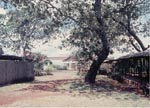 |
44. |
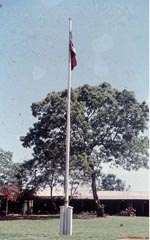 |
45. |
 |
46. |
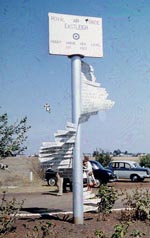 |
47. A curious signpost at RAF Eastleigh airport in Nairobi, giving the direction and distance to many cities throughout the world. |
Malindi R&R camp on the indian ocean |
|
|
|
|
 |
48. The camp from the beach with the NAAFI facility in the centre. |
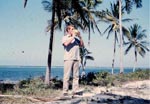 |
49. Bill partaking of the refreshing milk of an unripe coconut. |
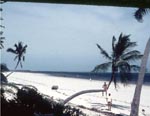 |
50. The Malindi beach and the ocean. |
 |
51. The Indian Ocean port of Mombassa with the famous tusks stradling the main road. |
1959 Out in the bush in the Garissa – Wajir area |
|
|
|
|
 |
54. A good-class road in the bush – no need for speed cameras here! (Perhaps!). |
 |
39. |
 |
40. |
 |
42. |
Astro fix point between Garissa and Wajir – May 1959 |
|
|
|
|
 |
38. As the searing heat of the day … |
 |
53. … gives way to the balmy warmth of the tropical night … |
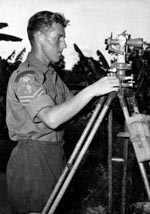 |
34. A typical Astro Fix crew consisted of three surveyors, three drivers (one of which would be a mechanic if possible) and three vehicles (a Land Rover, a Morris one-tonner carrying compo rations and a Bedford RL three-tonner carrying drinking water and petrol in 4½- gallon jerry cans and perhaps 44-gallon drums. An Astro Fix (determination of latitude and longitude at the point where the observations to the stars were made), would last on average from three to four days, with observations over two or three nights of about 5 to 6 hours a night. The computations were carried out during the day. (Now, someone who knows nothing about surveying, let alone astronomy, armed with a GPS costing a few hundred pounds, can achieve a far more accurate result in a few minutes.)
The crew would stay in the bush for anything from a week to three weeks before returning to base camp for rest and replenishment. |
Field trip to Garissa, Wajir and Lamu - May to June 1959 |
|
|
|
|
 |
37. Fort Wajir, a Kenya Police Post not far from the border with Somalia. It reminded me of the 1940’s Gary Cooper film ‘Beau Geste’ about the French Foreign Legion and I was told that more than one film-maker had used Wajir Fort as a ready-made film set. |
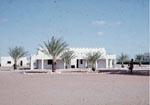 |
52. Fort Wajir, a Kenya Police Post not far from the border with Somalia. |
|
|
|
|
| |
|
|
|
|
|
|
|
| |
|
|
|
|
|
|
|
| |
|
|
|
|
|
|
|